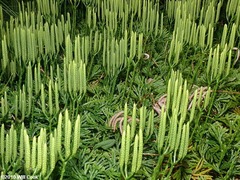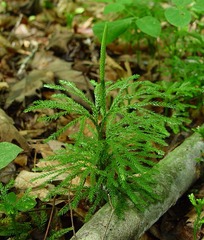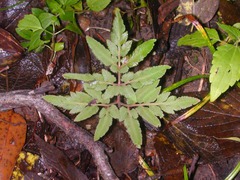Herbaceous Forest Plants – Flashcards
Unlock all answers in this set
Unlock answersquestion
alternation of generations
answer
A life cycle in which there is both a multicellular diploid form, the sporophyte, and a multicellular haploid form, the gametophyte; characteristic of plants.
question
androecium
answer
stamens collectively
question
anther
answer
the part of a stamen that produces and contains pollen
question
calyx
answer
the sepals of a flower collectively
question
carpel
answer
ovary, style and stigma; may occur singly or as one of a group
question
corolla
answer
the whorl of petals that collectively form an inner floral envelope or layer of the perianth
question
fern "seed"
answer
spore, not a seed
question
actinomorphic
answer
radial symmetry in a flower
question
zygomorphic
answer
bilateral symmetry in a flower
question
frond
answer
rachis and leaf of a fern
question
gametophyte
answer
in fern, tiny plant that produces sex cells
question
gynoecium (or pistil)
answer
female reproductive part of a flower
question
ovary
answer
part of female reproductive organ that contains ovules and ripens into a fruit
question
perianth
answer
the structures around the ovary: androecium, calyx and corolla
question
petal
answer
single part of corolla
question
pistil
answer
gynoecium, the female ovule-bearing part of a flower composed of ovary and style and stigma
question
seed
answer
a mature fertilized plant ovule consisting of an embryo and its food source and having a protective coat or testa
question
sepal
answer
one of the parts that form the calyx of a flower
question
sori
answer
cluster of sporangia
question
spore
answer
haploid reproductive cell that gives rise to a gametophyte
question
sporophyte
answer
the spore-producing individual or phase in the life cycle of a plant having alternation of generations
question
stamen
answer
the male reproductive organ of a flower; it contains the anther and filament
question
stigma
answer
the apical end of the style where deposited pollen enters the pistil
question
style
answer
the narrow elongated part of the pistil between the ovary and the stigma
question
allopolyploid
answer
A fertile individual that has more than two chromosome sets as a result of two different species interbreeding and combining their chromosomes.
question
chimera
answer
an organism with a mixture of genetically different cells
question
circinate vernation
answer
uncoiling of new leaves from the base towards the apex, as in ferns
question
cosmopolitan
answer
found all over the world
question
decumbent
answer
growing along the ground but with the tips rising or erect
question
fiddlehead
answer
the coiled young frond of various ferns - sometimes edible when cooked - also called crosier
question
indicator species
answer
a species whose presence or absence indicates the health of the ecosystem; or a species used to locate another less visible species
question
lycopodium powder
answer
spores of lycopodium species that had or still may have commercial applications
question
ptaquiloside
answer
chemical in bracken fern, brake fern (Pteridium aquilinum)
question
stolons (or runners)
answer
stems which grow at or below soil surface and form adventitious roots at the nodes
question
allicin
answer
Antimicrobial sulfur compound found in garlic
question
anethole
answer
Aromatic compound that is large component of the distinctive flavor of anise/fennel
question
berry
answer
a fleshy fruit developing from a single pistil, with several or many seeds
question
bulbil
answer
small bulb or bulb-shaped growth arising from the leaf axil or in the place of flowers
question
bulblet
answer
immature bulb which develops at the base of the bulb
question
calcium oxalate
answer
a chemical compound forming needle-shaped crystals called raphides. Even a small dose can burn, swell and choke, and large doses can cause death.
question
capsule
answer
a dry dehiscent seed vessel
question
compound umbel
answer
an inflorescence with small umbels (umbelets) at the ends of the branches (rays) of a large umbel
question
coniine
answer
poisonous compound in Conium maculatum (poison hemlock)
question
contractile root
answer
modified root that anchor itself by its tips and when dehydrated pulls itself deeper into the soil
question
corm
answer
a short, solid, vertical underground stem with thin papery leaves
question
dicot (or dicotyledon)
answer
a plant that has two seed leaves or cotyledons
question
monocot (or monocotyledon)
answer
a plant that has one seed leaf or cotyledon
question
phytophotodermatitis
answer
a inflammatory eruption of the skin caused by handling certain light-sensitizing botanical substances, especially in the Apiaceae family e.g. cow parsnip.
question
schizocarp
answer
a dry dehiscent fruit that at maturity splits into two or more parts each with a single seed
question
sheath
answer
an enveloping structure or covering enclosing a plant organ or part
question
spike
answer
an indeterminate inflorescence bearing sessile flowers on an unbranched axis
question
tepal
answer
an undifferentiated part of a perianth that cannot be distinguished as a sepal or a petal (as in lillies and tulips)
question
thermogenic
answer
producing heat
question
umbel
answer
flat topped or convex inflorescence with all pedicels arising from a common point (like an umbrella)
question
diphasic
answer
gender-switching
question
drupe
answer
fleshy indehiscent fruit with a single seed: e.g. almond
question
genet
answer
Individual plant arising from a single zygote
question
ramet
answer
individuals produced asexually from the genet
question
Lycopodiaceae
answer
Clubmoss family
question
Ophioglossaceae
answer
Adder's-tongue family
question
Polypodiaceae
answer
Fern family
question
Diphasiastrum digitatum (or Lycopodium digitatum - Lycopodiaceae)

answer
Running-pine (Clubmoss family)
question
Lycopodium digitatum (synonym for what?)
answer
Diphasiastrum digitatum (synonym for what?)
question
Lycopodium obscurum (or Dendrolycopodium obscurum - Lycopodiaceae)

answer
Ground pine (Clubmoss family)
question
Botrychium dissectum (Ophioglossaceae)

answer
Cut-leaved grape fern (Adder's-tongue family)
question
Alliaceae
answer
Onion family
question
Apiaceae
answer
Parsley family
question
Araceae
answer
Arum family
question
Araliaceae
answer
Ginseng family
question
Aristolochic acid
answer
Carcinogenic, mutagenic, and nephrotoxic compounds commonly found in the Aristolochiaceae
question
Balkan endemic nephropathy (BEN)
answer
BEN causes chronic kidney disease and upper urinary tract cancers. It is caused by accidental ingestion of Aristolochic acid (AA) affecting residents of villages along the Danube in Bulgaria, Romania, Serbia, Croatia and Bosnia-Herzegovina. People are slowly poisoned by eating bread made with flour contaminated with AA. Aristolocheae grow as weeds in their wheat fields. What does BEN stand for?
question
Convention on International Trade in Endangered Species (of Wild Fauna and Flora. What is it trying to do?)
answer
CITES is an international agreement between governments. Its aim is to ensure that international trade in specimens of wild animals and plants does not threaten their survival. (What does CITES stand for?)
question
Diphasic
answer
Sex switching
question
Drupe
answer
Fruit with (usually) a single seed enclosed in a hard layer and covered with soft, often juicy flesh, as in cherries or ginseng (which may have one or multiple seeds.
question
Gynostemium
answer
The fusion of both male and female parts (stamens and pistil) into a single organ. This means that the style and stigma of the pistil, with the filaments and one or more anthers, are all united.
question
Panicle
answer
A branched racemose inflorescence with flowers maturing from the bottom upwards
question
Raceme
answer
An un-branched, elongated inflorescence with pedicellate flowers maturing from the bottom upwards
question
Vulnerable plants
answer
Plants in danger of population decline with PA because of their beauty, economic value, or other factors, leading some people to remove these species from their native habitats
question
Aristolochiaceae
answer
Birthwort family
question
Achene
answer
small dry indehiscent fruit with the seed distinct from the fruit wall
question
Anemochory
answer
dispersal of seed, fruit, or other plant parts by wind
question
Compositae
answer
Old name for Asteraceae
question
Corymb
answer
flat-topped or convex inflorescence in which the individual flower stalks grow upward from various points on the main stem to approximately the same height
question
Cypsela
answer
The fruit of the Asteraceae is achene-like. What is it called? Although there are two fused carpels, there is only one locule, and only one seed per fruit is formed.
question
Epizoochory
answer
the transport of the seeds or fruits of plants on the surface of animal bodies (hairs, feathers, paws).
question
poison ivy
answer
Jewel-weed a folk cure for what?
question
Lydia E. Pinkham's vegetable compound
answer
One of the best known patent medicines of the 19th century containing five herbs, including White Wood Aster (Eurybia divaricata). Still available today.
question
Araliaceae (Ginseng family)
answer
Dicot. Simple umbels, 5 sepals, 5 petals, 5 stamens, fruit a drupe, INFERIOR OVARY-which family?
question
Apiaceae (Parsley family characteristics)
answer
Dicot. Compound umbels, 5 sepals, 5 petals, 5 stamens, fruit a schizocarp, INFERIOR OVARY (Name the family).
question
Alliaceae (Characteristics of the Onion family)
answer
Monocot. Simple umbel, 6 stamens, 6 tepals, fruit a 3-lobed capsule; SUPERIOR OVARY (what family?)
question
Raphides (are in which plant of the Araceae family)
answer
Skunk cabbage (Symplocarpus foetidus) Araceae family contains needle-like calcium oxalate crystals called -----?
question
globular mass (a compound fruit produced by what plant?)
answer
What kind of fruit is produced by Skunk cabbage (Symplocarpus foetidus)?
question
Skunk cabbage produces heat
answer
Symplocarpus foetidus is thermogenic (Common name and what does thermogenic mean?)
question
Is Wild sarsaparilla a colonial plant?
answer
Yes, Wild sarsaparilla (Aralia nudicaulis) is a colonial plant
question
wild sarsaparilla (monoecious or dioecious?)
answer
dioecious (Aralia nudicaulis)
question
Does Aralia racemosa sometimes have bright magenta stems?
answer
Yes, Spikenard has bright magenta stems sometimes
question
Primary biologically active constituents in Panax
answer
ginsenosides
question
Adaptogen
answer
Appears to protect the body against stress and restore homeostasis, as Ginseng
question
developmental stages of ginseng
answer
seedling; one-prong; two-prong; three-prong; four-prong
question
Overstory trees for Panax quinquefolius
answer
#1: Sugar maple (acer saccharum) #2: White ash (Fraxinus americana) #3: Basswood (Tilia americana) #4: Tulip poplar (Liriodendron tulipifera)
question
diphasic
answer
Panax trifolium (Dwarf ginseng) monoecious, dioecious or diphasic?
question
Balsaminaceae
answer
Balsam family
question
Tremetol
answer
Toxin found in Ageratina altissima (white snakeroot); causes Milk Sickness-killed Lincoln's mother
question
Pyrrolizidines
answer
Toxins found in Packera aurea (Golden ragwort) and other plants - damaging to liver
question
Asteraceae (give common name)
answer
Aster family (give latin name)
question
Aril
answer
A fleshy outgrowth of the funiculus, covering the seed, and generally functioning in animal seed dispersal
question
Autogamous
answer
Inbreeding, occurring within a single flower
question
Cruciform
answer
With four distinct petals in a cross shape
question
Eastern Asia-eastern North America floral disjunction
answer
The flora of the North Temperate Zone exhibits striking intercontinental floristic similarities. This similarity is most remarkable between eastern Asia and eastern North America. This represents the fragmentation of a once continuous Mixed Mesophytic forest community. What is the term for this?
question
Elaiosome
answer
a structure on the surface of some seeds generally containing oils attractive to ants, which act as dispersers of such seeds
question
Endemic
answer
a plant that is native to a certain limited area
question
Glucosinolate
answer
A chemical compound found in many Brassicales that functions to deter herbivory and parasitism and also serves as a flavoring agent in the commercially important members of the Brassicaceae
question
Invasive
answer
Usually a non-native plant that when introduced to an area takes over the niche of a native plant
question
Myrmechochory
answer
Seed dispersal by ants - elaiosome is food reward
question
Podophyllotoxin
answer
Present in the rhizome of American Mayapple (Podophyllum peltatum). A non-alkaloid toxin used on the skin to treat external genital warts, and in several anticancer agents.
question
Replum
answer
A septum, generally with attached seeds, that persists after fruit dehiscence, e.g. silicles and siliques of Brassicaceae
question
Rhizome
answer
A horizontal underground stem with shoots above and roots below serving as a reproductive structure
question
Silique
answer
A dry, dehiscent 2-carpeled fruit (esp. in Brassicaceae) that dehisces along two sutures, has a persistent partition (replum) and is longer than it is broad
question
Silicle
answer
A dry, dehiscent 2-carpeled fruit (esp. in Brassicaceae) that dehisces along two sutures, has a persistent partition (replum) and is as broad or broader than it is long
question
Tetradynamous
answer
with stamens in two groups of four long and two short (Brassicaceae stamen arrangement)
question
Xenogamous
answer
Outbreeding
question
Berberidaceae
answer
Barberry family
question
Brassicaceae
answer
Mustard family
question
Alliaria petiolata (Brassicaceae)
answer
Garlic-mustard (Mustard family)
question
Cardamine concatenata (Brassicaceae)
answer
Cut-leaved toothwort (Mustard family)
question
Cardamine diphylla (Brassicaceae)
answer
Two-leaved toothwort (Mustard family)
question
Uterine tonic
answer
Native American women prepared cohosh root (and other herbs) in a tea to ease labor pains, induce miscarriages, and ease menstrual pain.
question
Which family is notable for having a number of taxa that represent a long-recognized biogeographic phenomenon: the eastern Asia- eastern North America floral disjunction
answer
Berberidaceae (Barberry family is notable for having a number of taxa that represent a long-recognized biogeographic phenomenon: the eastern Asia- eastern North America floral disjunction)
question
Which three members of the Barberry family have similar genera in eastern Asia? (Number them in alphabetical order by Latin names)
answer
1. Caulophyllum thalictroides or Blue Cohosh 2. Jeffersonia diphylla or Twinleaf, 3. Podophyllum peltatum or Mayapple (three members of the Berberidaceae that are part of the eastern Asia-eastern North America floral disjunction)
question
Jeffersonia diphylla (Berberidaceae - describe fruit)
answer
a capsule, with a hinged lid; seeds numerous and each bearing an elaiosome (which plant-which family?)
question
Impatiens capensis (Balsaminaceae - describe fruit)
answer
a loculicidal capsule that is explosive at maturity. Which plant? (also which family?)
question
location of ovary in Balsaminaceae (or Alliaceae or others)
answer
superior ovary
question
Name a colonial plant
answer
Dennstaedtia punctilobula (Hay-scented fern) is colonial
question
What plant uses myrmechochory (any one of many)
answer
Asarum canadense (wild ginger) uses myrmechochory
question
Name a plant that uses anemochory
answer
Packera aurea (Golden ragwort uses anemochory)
question
Dichogamous
answer
Describes plant in which the male and female parts of a flower reach maturity at different times.
question
Diosgenin
answer
___ is a terpenoid compound found in Mexican yams, and is used as a precursor to the synthesis of progesterone
question
Geraniine
answer
A valuable astringent obtained from the root of the Geranium maculatum
question
Marker degradation
answer
Developed by American chemist Russell Earl Marker in 1938-40, it is used for the production of sex hormones from plant steroids.
question
Methyl salicylate
answer
oil of wintergreen
question
Monotropa uniflora (Ericaceae) (what is the name of the symbiotic relationship this plant has with fungi)
answer
Myco-heterotrophy (a symbiotic relationship between certain kinds of plants and fungi, in which the plant gets all or part of its food from parasitism upon fungi rather than from photosynthesis.) Name a plant that is a myco-heterotroph.
question
Tuber
answer
a fleshy underground stem or root serving for reproductive and food storage
question
Urceolate
answer
urn-shaped
question
Teaberry (wintergreen)
answer
Gaultheria procumbens
question
Dioscorea villosa (or quaternata) (Dioscoreaceae)
answer
Wild yam (Yam family)
question
Liliaceae
answer
Lily family
question
Melanthiaceae
answer
Death Camas family
question
Orchidaceae
answer
Orchid family
question
Disjunct distribution
answer
Occurrence of widely distributed and isolated populations or species within a taxon
question
Facultatively xenogamous
answer
Optionally xenogamous - can self when pollinators not present
question
Hemi-parasite
answer
a parasitic plant that contains some chlorophyll and therefore is capable of photosynthesis
question
Holo-parasite
answer
A plant that relies completely on a host plant. Non-photosynthetic.
question
Monotypic
answer
a monotypic taxon is a taxon that has only one species e.g. Medeola virginiana
question
Keystone species
answer
a species that is critical to the functioning of the ecosystem in which it lives because it affects the survival and abundance of many other species in its community
question
Sanguinarine
answer
name of the commercially important alkaloid found in bloodroot; used in toothpaste and mouthwash
question
Succulent
answer
a plant adapted to arid conditions and characterized by fleshy water-storing tissues that act as water reservoirs
question
Labellum
answer
the lower petal of an orchid, the lip
question
Labiate (or bilabiate)
answer
having lips or parts that resemble lips
question
Mycotrophy
answer
the symbiotic relationship between a fungus and a living plant
question
Spring ephemeral
answer
forest wildflower that blooms briefly in the Spring prior to leaf-out of the canopy
question
Staminode
answer
Sterile stamen
question
Circumboreal
answer
comprising or throughout far northern regions
question
decussate
answer
arrangement of opposite leaves or other structures at right angles to the preceding pair
question
Deer browse indicator
answer
size and health of palatable plants to deer indicates the size of the herds; also deer browse-resistant exotic-invasive understory vegetation presents an elevated risk of human exposure to the vector tick of Lyme disease
question
didynamous
answer
four stamens, 2 long and 2 short
question
Orobanchaceae
answer
Broom-rape family
question
Papaveraceae
answer
Poppy family
question
(Onion family has) superior (hypogynous ovaries)
answer
position of ovary in Alliaceae
question
(Arum family has) superior (hypogynous ovaries)
answer
position of ovary in Araceae
question
(Balsam family has) superior (hypogynous ovaries)
answer
position of ovary in Balsaminaceae
question
(Barberry family has) superior (hypogynous ovaries)
answer
position of ovary in Berberidaceae
question
(Mustard family has) superior (hypogynous ovaries)
answer
position of ovary in Brassicaceae
question
(Colchicum family has) superior (hypogynous ovaries)
answer
position of ovary in Colchicaceae
question
(Heath family has) superior (hypogynous ovaries)
answer
position of ovary in Ericaceae
question
(Geranium family has) superior (hypogynous ovaries)
answer
position of ovary in Geraniaceae
question
(Lily family has) superior (hypogynous ovaries)
answer
position of ovary in Liliaceae
question
(Death Camas family has) superior (hypogynous ovaries)
answer
position of ovary in Melanthiaceae
question
(Broom-rape family has) superior (hypogynous ovaries)
answer
position of ovary in Orobanchaceae
question
(Poppy family has) superior (hypogynous ovaries)
answer
position of ovary in Papaveraceae
question
(Parsley family has) inferior (epigynous ovaries)
answer
position of ovary in Apiaceae
question
(Ginseng family has) inferior (epigynous ovaries)
answer
position of ovary in Araliaceae
question
(Birthwort family has) inferior (epigynous ovaries)
answer
position of ovary in Aristolochiaceae
question
(Aster family has) inferior (epigynous ovaries)
answer
position of ovary in Asteraceae
question
(Yam family has) inferior (epigynous ovaries)
answer
position of ovary in Dioscoreaceae
question
(Orchid family has) inferior (epigynous ovaries)
answer
position of ovary in Orchidaceae



